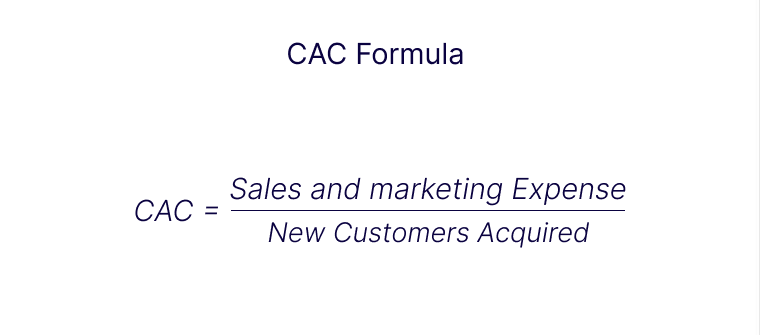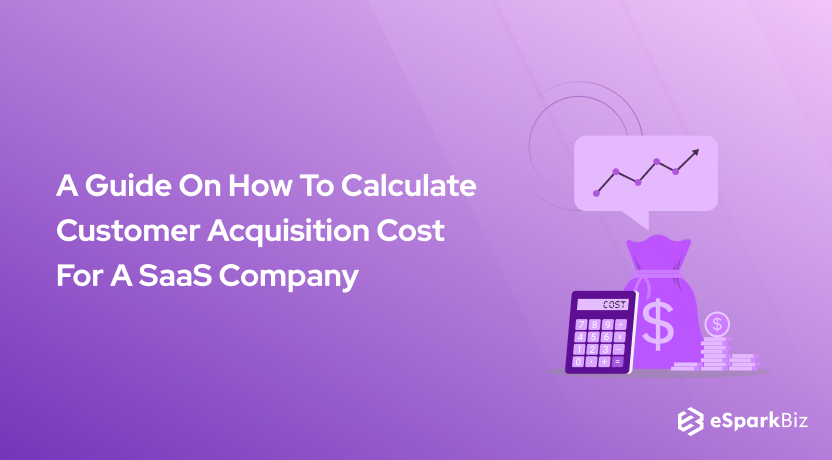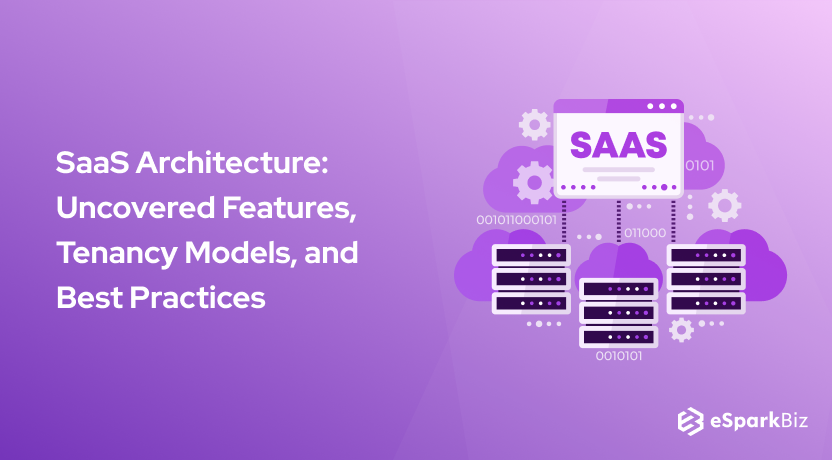Have you ever heard of it? If you have, then you might be well aware of the cloud technology and the different services that it has to offer. Today, we’re going to explore how to calculate Customer Acquisition Cost for a SaaS company.
Even if not, let me start this blog by briefly explaining what SaaS is. Short for Software-as-a-Service, SaaS is one of the delivery models that offer you cloud services based on your subscription.
It is one of the major services that a cloud can offer. You can say that SaaS is responsible to provide you with services that a third party offers by making use of the internet as its medium.
Let me list some of the apps that offer SaaS services.
- Dropbox
- SAP Concur
- Salesforce
- Cisco WebEx
- Google GSuite
If you want to build one such application for your enterprise, hire dedicated developers who can put in their expertise to develop app solutions for you in budget.
Did you know that most of the SaaS companies make use of CAC? Let’s find out more about it!
What Is Customer Acquisition Cost (CAC)?
Now, does anything come to your mind when you read Customer Acquisition Cost? Even if not, I’ll provide you with some information.
The term depends on the idea of winning over your customers and pursuing them to buy the goods and services that you have to offer.
Calculating and Predicting the approximate CAC for a company depends on many factors. The formula used to calculate CAC is what you should be aware of next.
As per the studies, there are two ways to find out the CAC, they include simple and complex methods. Both of these methods have a different set of rules, even formulas.
The CAC is a combined result of the cost of a product or service and the additional cost that is involved in that product or goods accessibility, manufacturing, marketing, research, etc.
Did you know that it is CAC that helps a company define if a customer is important or not?
So let’s look at how to calculate customer acquisition costs in the upcoming section. I bet you would like to learn and carry out the same procedure if you run a company or are a part of any kind of business.
Why Understanding CAC is Vital?
When it comes to a business, the future of how things you are working out is unpredictable. You can’t be 100% sure of how well your customers or the audience, in general, would perceive the services that your company has to offer.
The same happens in SaaS companies as well. To be somewhat aware of the direction in which they might be dipping, many of the major SaaS companies rely on CAC calculations.
The CAC calculations can offer them with the approximate result for the number of customers that they would gain in the future. The company can then invest accordingly into resources to ensure that all of the predicted outcomes are met.
The CAC Payback Model
A model is derived from the data collected so that the companies can have a better understanding of the payback period.
One of the many good things about CAC is that it not only tells you about the cost to acquire a customer but also gives you an idea about the period that your customers would ideally need to pay back their CAC.

Key Reasons To Understand CAC
Now, after having told you about what CAC is and the fact that most of the SaaS companies utilize it, you might have certain questions like why is it so important to understand the cost of customer acquisition?
Listed below are the three key reasons to know why understanding CAC is important.
Helps You To Optimize LTV/CAC Ratio: Do you know about LTV? It is the lifetime value ratio that focuses on maintaining relationships with customers. Maintaining the LTV/CAC ratio to a minimum of 3 is ideal.
What I mean by this is the ratio should be in such a way that you acquire a minimum of $3 when you invest $1. This can help you as a company to be in check with your goals of achieving high profits.
Determine & Optimize CAC Payback Period: Payback period is important when it comes to calculating CAC for a company.
The time that it will take for a company to recover the cost to acquire a customer. You can say that it is the time in which the investment made by a company reaches its breakpoint.
Tracking & Optimizing CAC Ratio: Once you know the Payback period, you can work on strategies to optimize it and to keep a track of it.
For every new customer that you gain, you lose some of the money that you invested. Your focus should be on finding out ways to get that money back.
Why CAC Is Important For SaaS Business?
SaaS business is all about offering services to customers at a minimum rate.
The cost of goods and services in this business is not much, so the company can acquire as many customers as it can at a low yield. You also need to know about the SaaS Pricing Models.
They can then eventually earn a profit after providing months of services to the customer at a low yield. When compared to the LTV which is Lifetime value ratio, their relationship can be given by the equation:
LTV = 3 * CAC
So, as a customer acquisition cost example, if a company’s CAC is $100, then as per the equation, its LTV should be $300.
This can help a company decide how much it can spend against the value of an asset.
What to Include In CAC?
We have discussed what CAC is and how it is important for any SaaS company. But, what are the things that can be included in the cost of customer acquisition? And how would it affect the company or the CAC itself? Let’s find out.
The two factors that I think should be considered are:
Sales & Marketing Expenses
Sales and marketing are an important part of any business organization. It is also the company’s responsibility to balance the expenses in this field.
Paying the employees that work for the company, along with the incentives that are offered to them is all a part of the company’s annual expense.
While calculating the CAC, I would say it is ideal to consider the expenses of tools needed to develop the system and the total amount that the company spends.
New Customers Acquired
It is an obvious fact that a company would have multiple customers, maybe in lakhs, millions, or even more. Considering all of them while using the acquisition cost formula can cost a lot more to the company.
Instead, if the company only considers new customers while using the customer acquisition cost calculator, then it would be beneficial for them.
What Not To Include In CAC?
We saw what should ideally be included by a company while using the customer cost calculator.
Some companies have made the mistake of not including some of the expenses that should have been a part of the CAC.
Not including these factors, led the company’s total expense and CAC calculations to go haywire.
The mistakes that were made by the companies are:
- Not Include Salaries : Salaries of your employees are a major part of your expense. Employees are the ones that spend time coming up with marketing strategies, so their efforts should be considered while calculating the CAC.
- Not Include Overhead : Any of the overheads like equipment or rent that were a part of the marketing process or that were used by the employees while working on marketing strategies should be considered as a part of the CAC.
- Not Include Money Spent on Tools: When you use marketing tools, it makes the entire process a lot more efficient. The amount spent on them should be a part of the CAC too.
How To Calculate Customer Acquisition Cost?
Now, when it comes to the question of how to calculate acquisition cost, we can say that it is dependent on two of the most important factors.
These factors include the customer acquisition cost formula and the success rate of the relationship between the CAC and the customer.
The CAC Formula

The use of CAC has been increasing over the years in internet-oriented companies. It is widely used in SaaS provider companies.
To put it into simple words, the CAC formula consists of the amount spent on gaining new customers divided by the number of customers gained.
Mathematically, the formula can be represented as
CAC= Total Cost of getting new customers/ Total number of new customers gained.
CAC & Customer Success
The success rate of a CAC to work efficiently depends on various factors.
The more successful and accurate the CAC is, the more it will help companies come up with strategies that can help them market their brand or products and services in a better way.
It can help them to know what they need to invest in order to increase the number of customers viewing or creating their profiles.
Understanding the LTV:CAC Ratio
After having seen the CAC ratio, let’s see what the LTV ratio is. LTV or CLV customer lifetime value is a term used in marketing strategies that helps a company to determine whether their customers are happy with the services that the company is providing or offering to them.
This ratio can determine how efficient your sales are. Using LTV along with CAC can prove to be very beneficial for your company.
While LTV deals with maintaining relationships between your company and the customers that you have, CAC focuses on the ways to attract new customers.
If I ask you, what is a good customer acquisition cost, what would your answer be? To be honest with you, there is no specific answer to that.
As a company, I would like to say that your focus should be more on maintaining a good LTV rather than spending more on the CAC.
The main reason behind this is that CAC requires you to invest more if you want to gain more customers. LTV on the other hand wouldn’t need any extra expense to carry out its operations.
A combination of both LTV and CAC together contributes to a business model but the importance that you give to either of them depends on you.
Understanding Both The Business Models
In the image given below, two business models have been shown. Both of them contain LTV and CAC but they aren’t the same.
One of them is titled as a good business model whereas the other is titled as a bad business model. So what caused this difference? The answer is right in front of you.

The first model focused more on the LTV than the CAC while the second model did the vice versa.
What happened here is that, by focusing more on the LTV, the company did not have to bear any extra expenses and the money that they spent was in small amounts and was easily recoverable. They also made more profit than they had expected.
On the other hand, the second model focused more on CAC and had to bear greater expenses that weren’t recoverable easily. They also couldn’t make much profit.
I hope you understand what the image portrays and focus on LTV rather than CAC.
A Different Perception for CAC
There can be different ways to approach CAC. According to the model formulated by Dave Kellog, instead of the ideal dollar value comparison to LTV, you can compare the expenditure from the sales and marketing department of your company to your newly generated revenues.
Using this alternative method or this new perception can tell you the effectiveness of your latest expenditures from the sales and marketing departments.
CAC Payback Period
You know that CAC is the investment that companies make in their marketing strategies, sale, and products or services that they offer. It is also vital for knowing the Cost To Develop SaaS Applications.
These expenses are inevitable, you cannot avoid them. They include the basic need for you to successfully develop and launch any service or product.
As per the CAC calculations, there is a set amount of time that you’ll require to earn the money back that you had spent as expenses.
The amount of time needed is called the CAC Payback Period. It is usually measured as per time or as per the months that it would ideally require.
It is a critical factor for any company as the payback period determines the amount of cash you as a company will have to grow.
Knowing your CAC is the foremost step to calculate the payback period. There won’t be any CAC payback period without the CAC now, would there?
Apart from that, you will also need the results or the values of your company’s Gross Margin Percent and ARPA i.e. Average Revenue per Account.
To calculate the CAC Payback period, the CAC is divided by Average revenue per account multiplied by gross margin percent.
Calculating the Payback period has some pros and cons as well. They are as mentioned below:
Pros
- It helps to know the profit that you’d have to make.
- It helps to determine the capital efficiency, especially for a SaaS company.
- The company is likely to earn more profit if the payback period is less.
- It also helps to reduce the CAC.
Cons
- Need to use Relevant metrics
- Not tracking of every SaaS metric.
Gross Margin Adjusted CAC Payback Period
You can adjust the CAC as per your company’s gross margin. The amount that you spend as an expense should be less than or in balance with the profit or at least the income your company makes.
Once you determine the CAC, you can compare it with your company’s gross margin and then try to come up with strategies to reduce CAC and increase your profits.
Ways to Reduce the CAC
Less CAC means that your company won’t have to spend much on the expense. You can also say that less CAC means profit.
If your CAC is less, then the payback period to overcome that expense will become less. Some of the ways that you can implement to reduce CAC are:
- Optimize The Funnel: By optimizing the funnel, you can narrow down the number of visits to potential leads or customers.
- Optimize The Pricing Strategy: By optimizing your pricing strategy, you can reduce the CAC for your company. This would also result in a reduced payback period and an increased profit.
- Increase Efficiency of Sales & Marketing: CAC is all about marketing and sales, so focusing on the efficiency of these departments is necessary.
- Quickly Engage New Customers: New customers that you acquire should engage to the product in a less amount of time. This would increase the possibility of the customer to continue with the use of service.
- Inbound Marketing: Inbound marketing can help your business by offering ways to bring new leads via the funnel at minimal costs.
You as a company should aim to have a reduced CAC. Your main aim should be to reach out to people, acquire them as your customers, provide them with quality services, and eventually gain profits.
How CPA & CAC Are Different?
We had a look at the CAC.
Now let’s see what CPA is. Short for Cost per acquisition or cost per action, it is one of the metrics for marketing to measure the cost required for you to gain a customer for your company.
This customer would be willing to pay for the services that you have to offer.
There are many examples of the services that customer got under the CPA program. Some of them are as follows;
Dropbox
When it comes to the tasks and responsibilities, CAC and CPA are quite different from each other.


In the case of Dropbox, which is a hosting service for files and data, the CPA would include the registration cost for every free user and the cost for an activated free user.
This can help to know that a viewer of the service has become a user of the service.
HubSpot
It is one of the companies that develop marketing, customer service, and sales products. The CPA for it would include trial cost, cost per lead, the cost for a qualified lead, and many more.


I’m sure that you are aware of Facebook, its purpose, and the features that it offers.

Now, looking from a business perspective, there might be certain strategies that it follows. Along with that, you use CPA for activated user cost, registration cost, etc.
How to Calculate CAC in Real-Time Scenario?
Finding out the probability of a system is fine but it is also necessary to implement it in the real-time scenario.
Companies, especially the ones in the software and computer field, have to keep up with the new technologies.
Ensuring efficiency in your work is an integral part of your responsibility as a SaaS provider company. So, how to calculate customer acquisition cost in scenarios like this?
We have an answer for that.
Freemium Product
Ever used a freemium product before? Well, it is a kind of software product or service offered by organizations. All the customers are eligible for using the basic features offered by the product.
If they want to upgrade their account or the service that they receive, then they will have to pay for that. Dropbox is one of the examples of a freemium product.
You don’t pay for Dropbox when you use it for the first time. If you use up all the storage offered by Dropbox, then you’ll have to pay for more storage that is offered by the organization.
SaaS Company
Many saas development services offer Third-party services even as collaboration.
Usually, they give you a free trial of the services that they have to offer, and then if you wish to upgrade your account plan, you can pay for the same.
Conclusion
We learned about many terms and concepts about CAC and how it can be beneficial. Calculating CAC for your SaaS Company is not at all difficult.
You just need the right measure values to do so. For any further information, you can refer to the Internet. Thank You.!
-
How do you calculate CAC SaaS?
CAC is calculated by the dividing total cost of acquiring customers by a given time period by the total number of customers acquired over that period of time.
-
How do you calculate LTV SaaS?
The calculation for Customer Lifetime Value
Average purchase value: the company's total revenue/the number of purchases made in the same time period.
Average purchase frequency rate: Total number of purchases/Number of unique customers who made purchases during the same time period.
Average customer lifespan: The average number of years a customer continues to purchase from your company.
LTV= Average purchase value x Average purchase rate x Average Customer Lifespan
-
What Is The Average Customer Acquisition Cost?
The customer acquisition cost varies from one industry to the other. But, the average for travel is $7, retail is $10 and customer good is $22.
-
What’s A Good Customer Acquisition Cost?
It is said by the marketing experts that if your LTV (Customer Lifetime Value) to CAC (Customer Acquisition Cost) ration is 3:1, then you’re in a very good position, without any doubts.!









